In previous postings about this monastery (2154 and 2194) we took a closer look at the trapeza and the second courtyard, where monks were ‘crushing the olives’. Today we will take a closer look at the philae, that you can find in the first courtyard (look at the ground plan below). This plan dates from before the year 2000. As you can see the phiale is originally placed at spot B1 and it has a square shape. The phiale that we will examine closer today is placed at spot B2 and has a round – octagonal – shape (the blue round circle on the plan). This means this phiale is relatively new.

The phiale is octagonal shaped and is made of stone. I has eight columns and its dome is covered with lead.

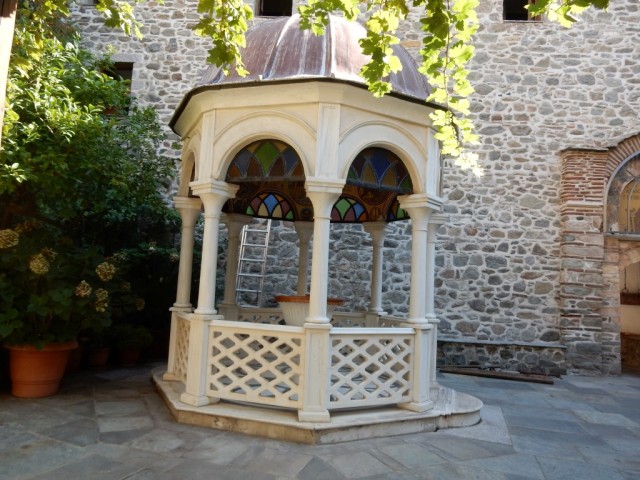
As we will read later in this post the interior is build up as follows: the first layer is made of stained glass that is placed in between the eight columns. Above each pillar is a small scene painted: the second layer consists of eight scenes painted in round circles, with eight saints in between them. In the dome are four major scenes and in the top of the dome you can see a large angel, surrounded by many small angels. Bertinos tells us in his comment that it is the “Angel of The Great Council”: “ο της Μεγάλης Βουλής Άγγελος” (thanks to all readers who helped me filling up te caps in my knowledge).
I will start showing you the dome:

The dome with the four major scenes and the angels. As you can see this part of the ceiling is now very much in decline and the paint is already coming off. The colors are still very bright and the paintings look relatively new.

Here in the center of the dome is a large image of an angel, holding a book (I could only read the word “megalis” meaning “big”: other texts are badly damaged, unfortunately). The centre angel is surrounded with a first blue colored ring with multiple winged angels, and a second ring with angels in white clouds (also damaged).
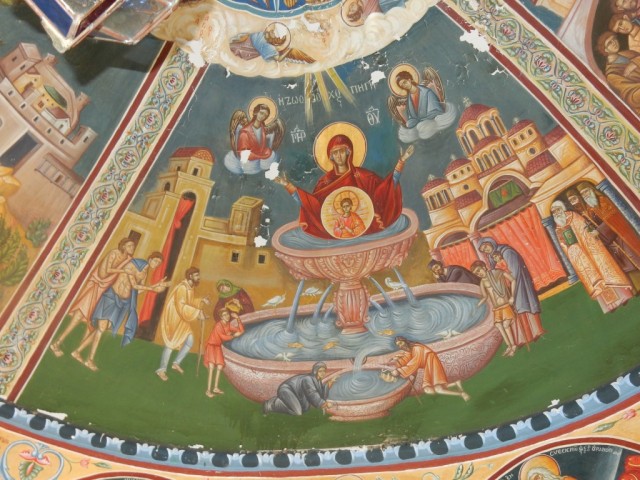
The first major scene: we see the Panaghia with the child Jesus emerging from a phiale, surrounded buildings and a church, with (sick) people (lepers), children, Holy men, and also with birds and fish and two angels on a cloud. Rays of light appear from above -Heaven. According to Bertinos this is an icon of the Mother of God as Life-giving Spring (Ζωοδόχος Πηγή).

The second major scene is from John 5 and depictst Jesus who says to a lame man: “Stand up, pick up your mat, and walk!” Instantly, the man was healed! He rolled up his sleeping mat and began walking! But because this miracle happened on the Sabbath the Jewish leaders objected (men on the left).

The third major scene is the baptizing of Christ by John the Forerunner (Prodromos). The Holy Spirit appears above him as a white dove. Angels stand on the shore looking at the baptism. On the other shore you can see a large (palm?) tree with an axe. Christ stands on a raft or hatch (?) with snakes around Him. Creatures show up in the water, with a man holding a jar, from which water flows, and a woman in the sea (thalassa?), riding a chariot on two large fish, while holding a sail ship in her hand. For me these last images do not make any sence, who can help?
The response came from Alex: the woman represents the Jordan River, the man generally the Sea (or visa versa), for more interesting information go here. The explanation of the image of the tree with the axe is put down in Matthew 3:10: “And even now the ax is laid to the root of the trees. Therefore every tree which does not bear good fruit is cut down and thrown into the fire”.
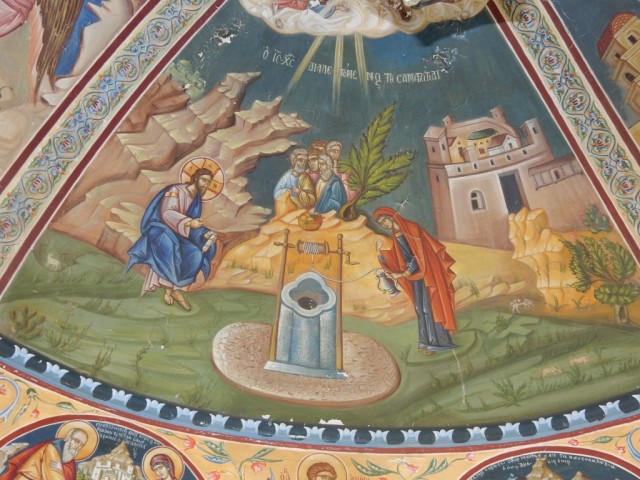
The fourth scene of from John 4: 6-7. It shows the Samaritan woman (Diane?) When Jesus was tired he rested by the well, when she came to get some water. Jesus asked her to give Him a drink. Jesus told her He could give her water that would cause her to never thirst again. He explained that He was the Messiah and that the water He offered her was the “living water” of eternal life. The woman went to the city and told many people what she had heard. They went to the well and spoke with Jesus themselves.
The next pictures show us the second layer consisting of eight scenes, painted in red round circles (by mistake I took pictures of only seven scenes):
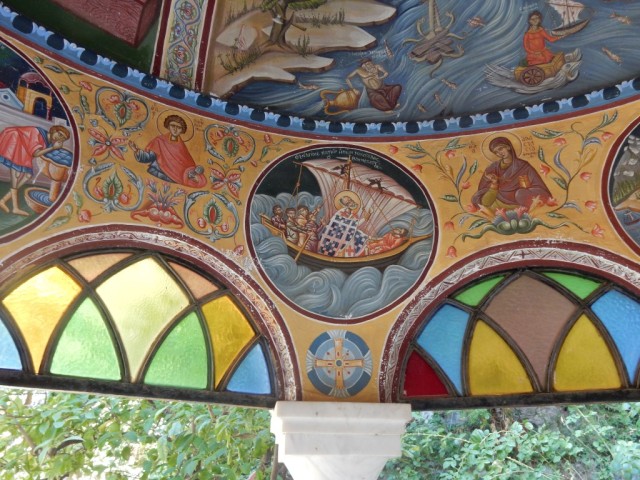
This is a scene with one of the miracles by Ag. Nicolaos: here he rescues sailormen who are in a severe storm. Two devil-like creatures appear on the mast of the ship. At left of the scene you see the ‘doctor’-Saint Panteleimonos and at right Agia Anastasia (with beautiful tulips alongside her?).

The next scene in the left red circle shows us the founder of the monastery, Ag. Grigorios (thanks Vasilis), holding a staff, with a small hut in a cave on a mountain (Mount Athos?) with a basket hanging on a rope, where water flows down in a stream. A small boat lies on the shore. In the middel Saint Tryphon from the 3th century is situated. I could’t work out what the scene displayed on the right is about. Acoording to the later comment of Vasilis I guessed correctly that we see Ag. Athananasios of Lavra touching the rock with his staff, where water flows from the rock (at the well of Athanasios) with the Panaghia watching. Behind them a monastery, probably Lavra, and the Holy Mountain (Athos).
Details of the second and the third scene above.
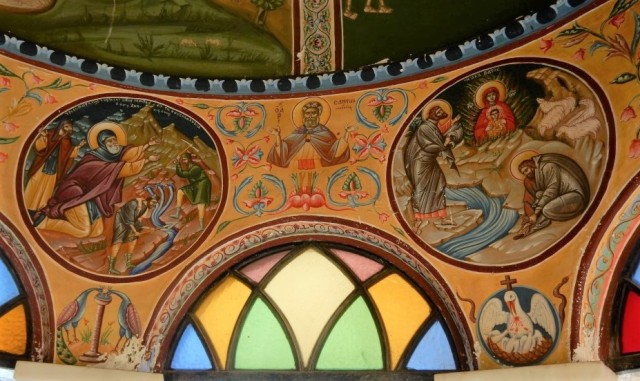
The fourth and fifth scene in the red circles: the scene at left shows us four men, one of them a Saint, who discover a spring in a mountain at Kavsokalivia. The fifth scene at right is called I Agia Vatos, again a scene where water flows out the rocks (here with four white sheep). Bertinos tells us that it is an icon of the Burning Bush (or Unburned Bush), at the same time revered by Moses (on the left) and where Moses unties his shoes out of reverence (on the right).
Details of the two red circles.
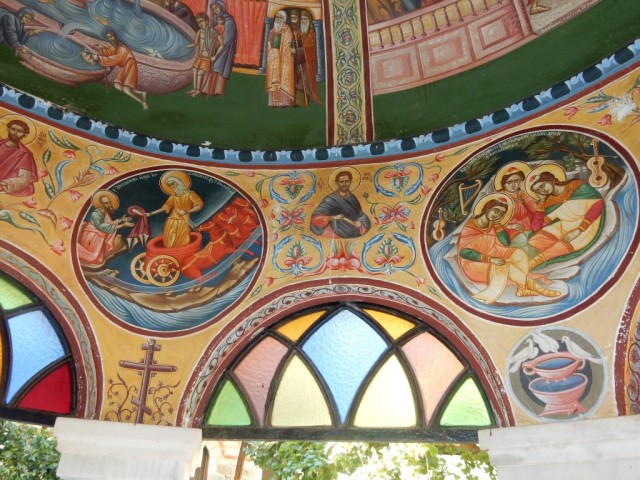
The sixth and seventh scenes: in the right red circle. The sixth scene depicts the Ascension of the Prophet Elias/Elijah into the heavens (II Kings 2:11), with his disciple Elisa/Eliseus standing left of him, receiving Elijah’s mantle.”By means of the mantle let fall from Elijah, Elisha miraculously recrossed the Jordan, and Elisha returned to Jericho, where he won the gratitude of the people by purifying the unwholesome waters of their spring and making them drinkable (thanks Bertinos).
The scene at right is well known by many of us because it refers to the song of Boney M: “By the rivers of Babylon” of Psalm 137:2. Here you see the musicians resting (“were we sat down”) and they hung their harps upon the willows on the banks Euphratis or Tigris river. The two Saints between the scenes are Damiamos and Kosmas.
Details of the two scenes.
The last three interesting images that I will describe are to be found above the pillars.

This is a famous story from the bible: Jonah and the whale. The Hebrew text actually uses the phrase dag gadol, which means “giant fish”, here painted in a clear way!
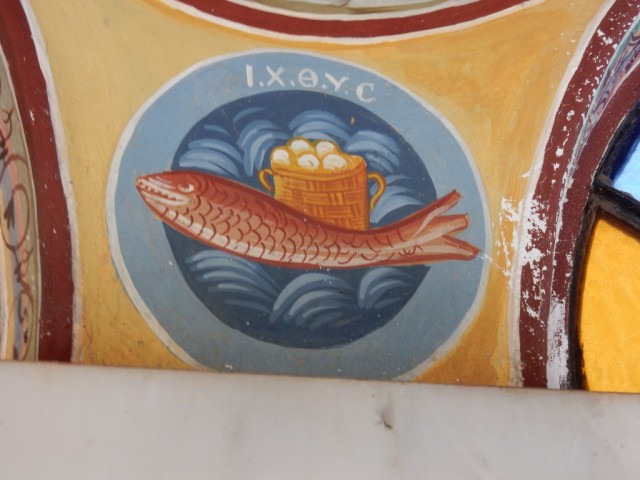
This image gave me some more problems: I did find the meaning of this abbreviation I.X.θ.Y.C. We see a fish and a basket with bread, with water in the background. Vasilis says in his comment: I.X.θ.Y.C. means ‘fish’ in Greek (ichthus) and the meaning of the letters is Jesus Christ Son of God Saviour (Ιησους Χριστός Θεου Ὑιός Σωτήρ).

This last image I found the most intriguing: here a pelican bird picks herself to protect her offspring. “The pelican loves its young so much that when snakes try to kill them it strikes its sides until blood comes out and with its blood brings them back to life.” Because of that belief, the pelican became a major symbol of self-sacrifice and charity. Early Christians had adopted it by the 2nd century and started using it in texts and images, making it a very special bird.
Furthermore you can see two different kind of crosses above the pillars, a scene three white doves drinking water from bowls and a scene with two eating peacocks.
It is obvious that the artist/painter of phiale tried to use “water” as a main theme for the scenes he choose to paint. He succeded very well in finding a large variety of biblical stories from the Bible, but also from local Athos legends. This phiale is extraordinary in many ways and is worth to be kept and renovated in time, because it seems its deterioration is going fast!
Wim Voogd, 28-02-2021

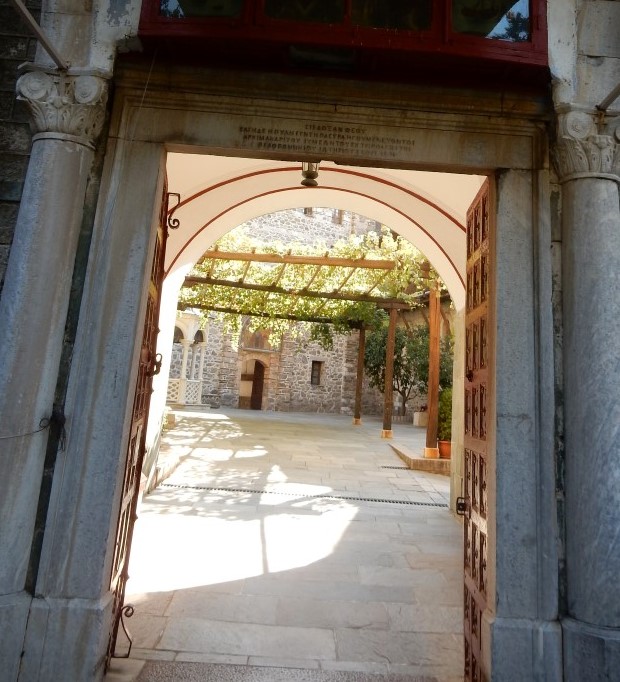





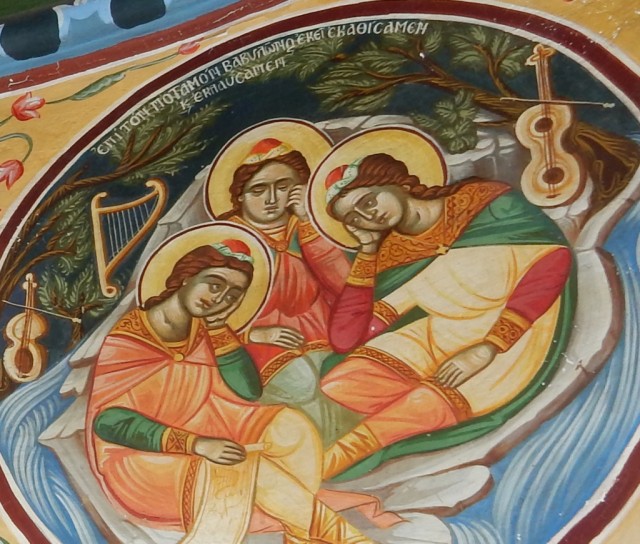
“On the other shore you can see a large (palm?) tree with an axe.”
“And even now the ax is laid to the root of the trees. Therefore every tree which does not bear good fruit is cut down and thrown into the fire”. Matthew 3:10
“…with (sick) people (small pocks?)”
two lepers
“For me these last images do not make any sence, who can help?”
The answer can be found here
https://russianicons.wordpress.com/2021/01/04/old-man-river/
Ι Χ Θ Υ Σ means fish in Greek. It is also the abbreviation of Ιησους Χριστός Θεου Ὑιός Σωτήρ: Jesus Christ Son of God Saviour. It is a secret symbol, only recognizable for Christians in the old days. Bread and fish may remind you the story told by the Evangelists.
“….a (Athos monk?) called Ag. Grigorios holding a staff” It is not just a monk, it is Saint Grigorios, the founder of the Monastery. On the picture right you may see Saint Athanasios, so not ‘like Athanasios’, but Athanasios himself creating the well.
The angel in the dome is Christ, represented as the “Angel of The Great Council”: “ο της Μεγάλης Βουλής Άγγελος” (Engel van de Grote Raad), a reference to Isaiah 9:6-7
You can find more about this type of icon on https://www.johnsanidopoulos.com/2013/12/the-angel-of-great-counsel-in.html
The “first major scene” is an icon of the Mother of God as Life-giving Spring (Ζωοδόχος Πηγή – https://en.wikipedia.org/wiki/Life-giving_Spring) as she is the source through whom Christ came in this world, thereby bringing eternal Life back to mankind.
The fifth scene (η αγία βάτος) is an icon of the Burning Bush (or Unburned Bush), at the same time revered by Moses (on the left) and where Moses unties his shoes out of reverence (on the right).
The sixth scene depicts the Ascension of the Prophet Elias/Elijah into the heavens (II Kings 2:11), with his disciple Elisa/Eliseus standing left of him, receiving Elijah’s mantle.”By means of the mantle let fall from Elijah, Elisha miraculously recrossed the Jordan, and Elisha returned to Jericho, where he won the gratitude of the people by purifying the unwholesome waters of their spring and making them drinkable” (https://en.wikipedia.org/wiki/Elisha).